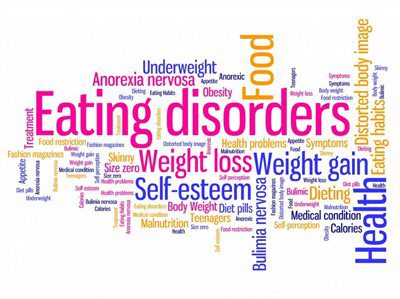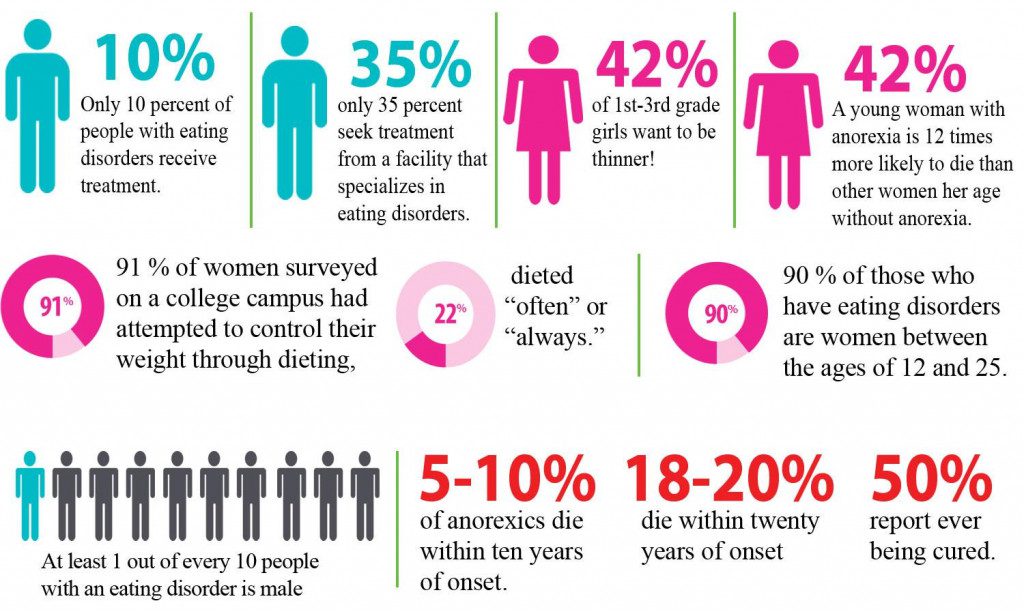Innovative Trials are passionate about ensuring our diverse population is adequately represented within medical research. Whether it is wanting to see more people from underrepresented communities choosing science as a career and pushing for greater patient diversity in clinical trials or focusing on what we are doing internally to celebrate and promote equality and diversity. So far in 2022, we have explored: Cervical Cancer and World Cancer Day
Overview
Eating Disorder s affect 9% of the population world wide (“Eating Disorder Statistics | General & Diversity Stats”). Eating disorders are debilitating mental illnesses that if go unaddressed can lead to serious and sometimes fatal consequences. The NHS says “An eating disorder is a mental health condition where you use the control of food to cope with feelings and other situations. Unhealthy eating behaviours may include eating too much or too little or worrying about your weight or body shape” (“Overview – Eating disorders”)
s affect 9% of the population world wide (“Eating Disorder Statistics | General & Diversity Stats”). Eating disorders are debilitating mental illnesses that if go unaddressed can lead to serious and sometimes fatal consequences. The NHS says “An eating disorder is a mental health condition where you use the control of food to cope with feelings and other situations. Unhealthy eating behaviours may include eating too much or too little or worrying about your weight or body shape” (“Overview – Eating disorders”)
The causes of eating disorders can vary from person to person however, common causes can include; trauma, genetics and societal/cultural factors may also play a role in the increased risk of eating disorders in the western world. Notably, some eating disorders are almost non-existent in countries that are not as exposed to the western ideals of ‘thinness’ than those that are eg. UK and USA. (“6 Common Types of Eating Disorders (and Their Symptoms)”)
Eating Disorders can affect anyone from any gender, or ethnicity; but teenagers between 13 and 17 are mostly affected and younger women and girls are further at risk of developing eating disorders. (“Learn about eating disorders – Beat”)
Diversity Eating Disorder Statistics:
- Black, Indigenous, and People of Colour with eating disorders are half as likely to be diagnosed or to receive treatment. (“Report: Economic Costs of Eating Disorders | STRIPED | Harvard TH Chan School of Public Health”)
- Gay men are seven times more likely to report binge-eating and twelve times more likely to report purging than heterosexual men (“Eating Disorders in LGBTQ+ Populations”)
- Women with physical disabilities are more likely to develop eating disorders. (Ekern)
Symptoms, Diagnosis and Treatment: (“Overview – Eating disorders”)
The most most common types of eating disorders include:
- Anorexia nervosa: people suffering from Anorexia often try to keep their weight as low as possible by not eating enough food or exercising too much
- Bulimia nervosa: people suffering from Bulimia may binge eat and then proceed to force themselves to throw up or take excessive amounts of laxatives to prevent them from gaining weight.
- Binge eating disorder: involves regularly eating a lot of food over a short period of time until you’re uncomfortably full.
People suffering from eating disorders are often only presented to health care professionals for help as a result of concern from their loved ones, this is often due to the belief that the person suffering from the eating disorder does not believe they have an issue that needs to be addressed with professional help. (“Learn about eating disorders – Beat”)
The biggest barrier people with eating disorders face is actually receiving the treatment they need, the first step the person suffering from an eating disorder (ED) must take is visiting their GP or family practitioner. This can be especially difficult as they will likely have felt pressured to make this visit by a concerned family member so may not be willing to be honest or comply with the Health Care Practitioner (HCP) in order to receive proper treatment, especially since they may not believe there is necessarily anything to treat. This visit can also be especially difficult and triggering for someone suffering from EDs as things like weight and body fat percentage may need to be taken by the HCP.
Something that is often not discussed is the requirements patients with EDs must meet to be considered ‘sick enough’ for treatment for example; you are required to be under a certain weight which is often measured through BMI – a tool we now understand was invented by a man who collected his data from predominantly white European men – this is problematic due to the fact that we now use this same data, to measure the BMI of both males and females and from all ethnicities and backgrounds, not considering things like muscle mass or bone density. (Jackson)
Treatment from eating disorders will be dependent on the type of ED however, it will usually include some sort of talking therapy such Cognitive behavioural therapy (CBT) alongside some medication for depression or anxiety. In extreme cases patients may need to be admitted to rehab as an inpatient. (“Learn about eating disorders – Beat”)
As a patient recruitment company, our recommendation to best approach patients suffering from Eating Disorders is to include their support system as much as possible. A common misconception with eating disorders is that with treatment the patient will be cured, however this often not the case. People suffering from eating disorders may find that it is a lifelong battle to overcome the harmful attitudes towards body image and food they have. The most effective way to do this is through community outreach and educating the families of patients in what potential triggers may be and how best to approach and support your child or loved one, should you be concerned they are suffering from an eating disorder.
Understanding that Eating Disorders affect the younger population the hardest, it is also important to consider what we can do in wider society to reduce this. Although this is a big challenge given the presence of social media in the lives of young people, over recent years there has been a huge shift in society’s view on body image and attitude towards mental health. Recognising the need for educating the younger population about the harmful effects of eating disorders and dealing with potential causes such as trauma through something like therapy would be highly beneficial, although we recognise this is not a simple nor quick fix.
My experience with eating disorders:
“ A close family member suffered from anorexia severely for a number of years. The road to recovery and treatment was a long one, there were many interventions, tears and arguments before they finally agreed to see a professional. It was an incredibly painful experience, watching someone you love essentially slowly killing themselves by depriving themself of the something we all need – food. I did not understand at the time why? Why won’t you eat? Not understanding that it was so much more than just restriction, it was about control when everything else felt chaotic. It is important that we realise it’s not as simple as just eating a pizza to cure a mental illness that at least in my experience, had very little to do with food. My advice to the support systems of those suffering from EDs is to be very patient and be careful with how you might talk about food. Something I came to learn the hard way was that talking about calorie counting or labelling certain foods as ‘bad’ was a huge trigger for someone suffering with anorexia. Which is why I think educating patients’ support systems can be key to recovery for those suffering from EDs”
Useful links
https://www.beateatingdisorders.org.uk/
References
- The UK’s Eating Disorder Charity – Beat, https://www.beateatingdisorders.org.uk/. Accessed 11 February 2022.
- “Eating Disorders in LGBTQ+ Populations.” National Eating Disorders Association, https://www.nationaleatingdisorders.org/learn/general-information/lgbtq. Accessed 11 February 2022.
- “Eating Disorder Statistics | General & Diversity Stats.” ANAD, https://anad.org/eating-disorders-statistics/. Accessed 11 February 2022.
- Ekern, Baxter. “Disabilities and Eating Disorders and Their Connection.” Eating Disorder Hope, 8 May 2019, https://www.eatingdisorderhope.com/blog/connection-disabilities-eating-disorders. Accessed 11 February 2022.
- “Ethnic differences in eating disorder prevalence, risk factors, and predictive effects of risk factors among young women.” NCBI, 23 November 2018, https://www.ncbi.nlm.nih.gov/pmc/articles/PMC6382562/. Accessed 11 February 2022.
- Jackson, Adele. “The Racist History of the BMI – Racist Origins of Fighting Obesity.” Good Housekeeping, 23 February 2021, https://www.goodhousekeeping.com/health/diet-nutrition/a35047103/bmi-racist-history/. Accessed 11 February 2022.
- “Learn about eating disorders – Beat.” Beat Eating Disorders, https://www.beateatingdisorders.org.uk/get-information-and-support/about-eating-disorders/. Accessed 11 February 2022.
- “Overview – Anorexia.” NHS, https://www.nhs.uk/mental-health/conditions/anorexia/overview/. Accessed 11 February 2022.
- “Overview – Eating disorders.” NHS, https://www.nhs.uk/mental-health/feelings-symptoms-behaviours/behaviours/eating-disorders/overview/. Accessed 11 February 2022.
- “Report: Economic Costs of Eating Disorders | STRIPED | Harvard TH Chan School of Public Health.” Harvard T.H. Chan School of Public Health, https://www.hsph.harvard.edu/striped/report-economic-costs-of-eating-disorders/. Accessed 11 February 2022.
- “6 Common Types of Eating Disorders (and Their Symptoms).” Healthline, https://www.healthline.com/nutrition/common-eating-disorders#causes. Accessed 11 February 2022.
